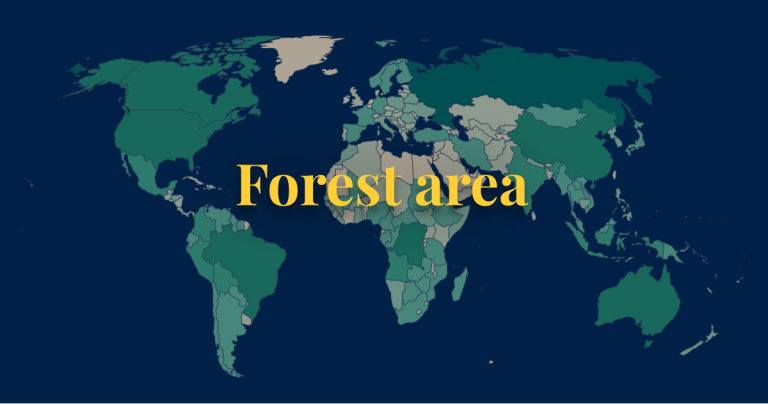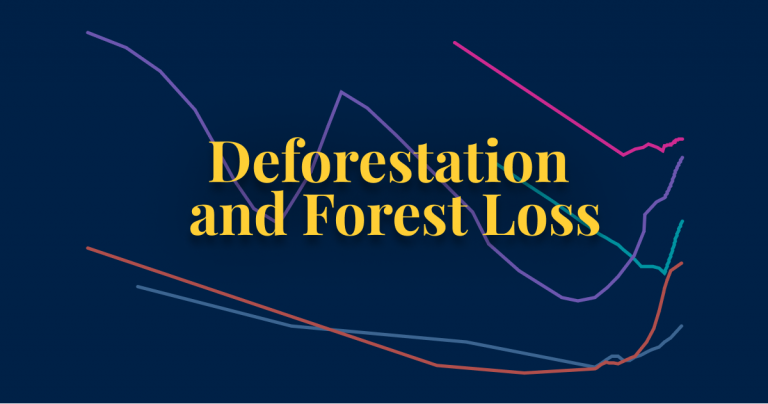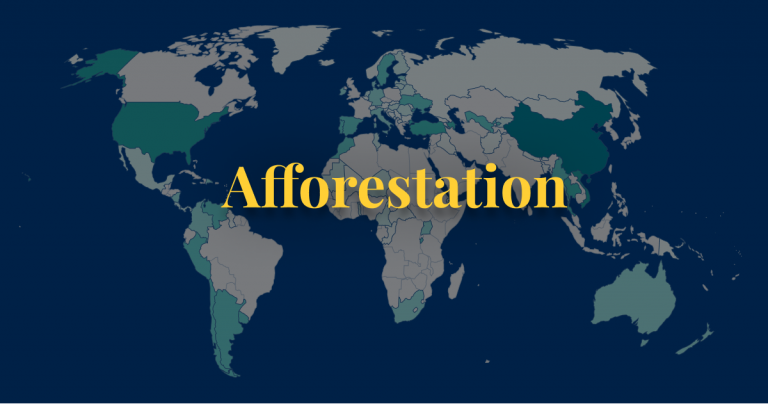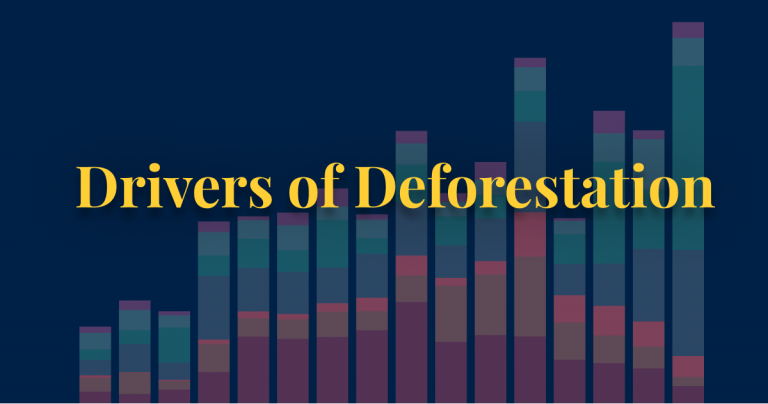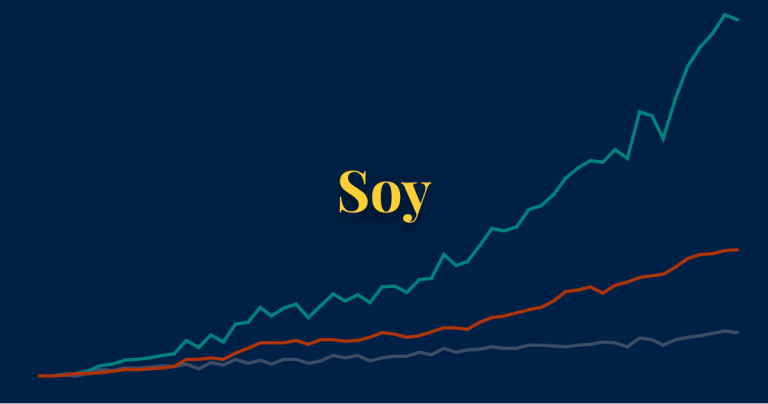Before we look at trends in afforestation across the world specifically, it’s useful to understand the net change in forest cover. The net change in forest cover measures any gains in forest cover – either through natural forest expansion or afforestation through tree-planting – minus deforestation.
This map shows the net change in forest cover across the world. Countries with a positive change (shown in green) are regrowing forest faster than they’re losing it. Countries with a negative change (shown in red) are losing more than they’re able to restore.
A note on UN FAO forestry data
Data on net forest change, afforestation and deforestation is sourced from the UN Food and Agriculture Organization’s Forest Resources Assessment. Since year-to-year changes in forest cover can be volatile, the UN FAO provide this annual data averaged over five-year periods.
Forest expansion
This interactive map shows rates of forest expansion across the world.
Forest expansion is the sum of natural forest expansion – trees that regrows on formerly forested land – and afforestation, which is deliberate seeding or tree-planting. Data on afforestation specifically is shown in the next section.
A note on UN FAO forestry data
Data on net forest change, afforestation and deforestation is sourced from the UN Food and Agriculture Organization’s Forest Resources Assessment. Since year-to-year changes in forest cover can be volatile, the UN FAO provide this annual data averaged over five-year periods.
Afforestation
One way that forest cover can increase is through natural forest expansion – when trees return to land that was previously forested but had been converted to an alternative land use. The other is through afforestation – deliberate restoration through seeding and tree-planting.
This interactive map shows the rates of afforestation across the world.
A note on UN FAO forestry data
Data on net forest change, afforestation and deforestation is sourced from the UN Food and Agriculture Organization’s Forest Resources Assessment. Since year-to-year changes in forest cover can be volatile, the UN FAO provide this annual data averaged over five-year periods.
There is a marked divide in the state of the world’s forests. In most rich countries, across Europe, North America and East Asia, forest cover is increasing, whilst many low-to-middle income countries it’s decreasing.
But, it would be wrong to think that the only impact rich countries have on global forests is through changes in their domestic forests. They also contribute to global deforestation through the foods they import from poorer countries.
Today, most deforestation occurs in the tropics. 71% of this is driven by demand in domestic markets, and the remaining 29% for the production of products that are traded. 40% of traded deforestation ends up in high-income countries, meaning they are responsible for 12% of deforestation.1
Let’s take a look at which countries are causing deforestation overseas and the size of this impact.
How much do people in rich countries contribute to deforestation overseas?
To investigate this question, researchers Florence Pendrill et al. (2019) quantified the deforestation embedded in traded goods between countries.2 They did this by calculating the amount of deforestation associated with specific food and forestry products, and combining it with a trade model.
In the map we see the net deforestation embedded in trade for each country. This is calculated by taking each country’s imported deforestation and subtracting its exported deforestation. Net importers of deforestation (shown in brown) are countries that contribute more to deforestation in other countries than they do in their home country. The consumption choices of people in these countries cause deforestation elsewhere in the world.
For example, after we adjust for all the goods that the UK imports and exports, it caused more deforestation elsewhere than it did domestically. It was a net importer. Brazil, in contrast, caused more deforestation domestically in the production of goods for other countries than it imported from elsewhere. It was a net exporter.
Although there is some year-to-year variability [you can explore the data use the timeline on the bottom of the chart from 2005 to 2013] we see a reasonably consistent divide: most countries across Europe and North America are net importers of deforestation i.e. they’re driving deforestation elsewhere; whilst many subtropical countries are partly cutting down trees to meet this demand from rich countries.
Most deforestation occurs for the production of goods that are consumed within domestic markets. 71% of deforestation is for domestic production. Less than one-third (29%) is for the production of goods that are traded.
High-income countries were the largest ‘importers’ of deforestation, accounting for 40% of it. This means they were responsible for 12% of global deforestation.3 It is therefore true that rich countries are causing deforestation in poorer countries.
Many rich countries are driving deforestation in other parts of the world, but are regrowing forests domestically. 79% of exported deforestation ended up in those countries that had stopped losing domestic forests.
How do these two measures compare? Are they causing more deforestation elsewhere than they are regenerating in forests at home?
Let’s take an example. Imagine some temperate country was responsible for the deforestation of 25,000 hectares in tropical countries but was restoring its own forests at a rate of 50,000 hectares per year. On balance, it would still have a positive impact on the size of global forests; its net contribution would be increasing forest area by 25,000 hectares.4 However, this country might still be causing more damage than this for a couple of reasons. Not all forest is equal. Tropical forests are often more productive than temperate forests, meaning they store more carbon. They are also richer sites of biodiversity. And, we might place more value on preserving primary, native forests that haven’t yet been deforested over regrowing forests that have lost their previous ecosystems. Hence, we should keep in mind that forest area is not the only aspect that matters – where that forest is and how rich in life it is matters too.
It would be good if there was data available that would capture these additional aspects. We manage to capture some of these differences in carbon in our related article on deforestation emissions embedded in trade. Without reliable metrics that capture all of these differences, we will have to stick with total changes in forest area for now. But we should keep these important aspects in mind when comparing forest losses and gains.
In the chart we see the comparison between the change in domestic forest area, and deforestation driven by imported goods.5 On the vertical axis we have the domestic change in forest area: this is shown only for countries where the forest area is increasing. Since there is often year-to-year variability in deforestation or reforestation rates, this is shown as the five-year average. On the x-axis we have imported deforestation. The grey line marks where the area of domestic regrowth of forests is exactly equal to imported deforestation. Countries that lie along this line would have a net-neutral impact on global forests: the area they are causing to deforestation overseas is exactly as large as the area they are regrowing at home.
Countries which lie above the grey line – such as the United States, Finland, China – restore more forest each year domestically than they import from elsewhere. For example, the US ‘imported’ 64,000 hectares of deforested land, but increased its domestic forest area by 275,000 hectares. More than four times as much. On balance, they add to the global forest stock.
Countries below the line – such as the UK and Germany – are not growing forests fast enough to offset the deforestation they’re creating elsewhere. The UK ‘imported’ 34,000 hectares of deforestation but increased its domestic forests by only 19,000 hectares. These countries might have high levels of afforestation at home, but they’re still having a net negative impact on the size of the world’s forests.
After seeing this data, people might argue that we should cut back on trade. If poorer countries are cutting down forests to make food for rich consumers, then we should just stop trading these goods.
But the solution is not so simple. There are other aspects to consider. International trade is important for socioeconomic development. Many farmers rely on international buyers to earn a living and improve their livelihoods. Not only would this be bad for people, it might also be bad for forests.
One of the reasons poorer countries clear forest to make room for farmland is that they achieve low crop yields. If you struggle to increase crop yields but want to produce more food, then expanding your agricultural land is the only option. This often comes at the cost of forests. Improvements in agricultural productivity tends to both drive and follow economic growth. International trade plays an important role in this growth, and may allow farmers to see the yield gains they need to produce more food using less land.
So, what can we do?
One option is to adopt stricter guidelines on what suppliers to source from, and implementing zero-deforestation policies that stop the trade of goods that have been produced on deforested land. Another way that richer countries can contribute is by investing in technologies – such as improved seed varieties, fertilizers and agricultural practices – that allow farmers to increase yields. That’s both an economic and environmental win.
The first step in doing this is for rich countries to monitor their deforestation impacts overseas more closely. They should keep their domestic reforestation targets in perspective with their net impact on global forests. Sometimes these restoration programmes pale in comparison to the deforestation they’re driving elsewhere.
